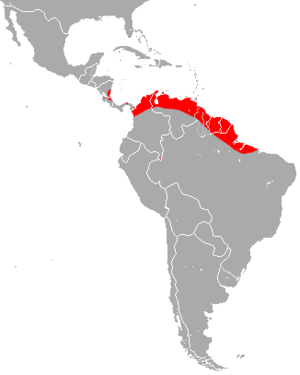Short-eared bat facts for kids
Quick facts for kids Short-eared bat |
|
|---|---|
| Conservation status | |
| Scientific classification | |
| Genus: |
Cyttarops
|
| Species: |
alecto
|
 |
|
| Short-eared bat range | |
The short-eared bat (Cyttarops alecto) is a special type of bat. It lives in countries like Brazil, Costa Rica, Guyana, and Nicaragua. This bat is the only species in its group, called a genus.
Contents
Discovering the Short-Eared Bat
The short-eared bat is a dark-colored sac-winged bat. It looks a bit like other bats such as Saccopteryx or Peropteryx. However, you can tell it apart by its long, soft fur and round, low-set ears. It also has special bones, like expanded collarbones and grooved shin bones. Its skull has a unique shape too.
What Does It Look Like?
These bats have forearms that are about 46 to 47 millimeters long. That's about the length of a large paperclip! Their skulls are quite small, measuring about 13 to 14 millimeters. Female bats are usually a little bigger than the males.
How They Find Their Way: Echolocation
Like many bats, short-eared bats use a special skill called echolocation. This means they send out sounds and listen for the echoes to find things. Their calls have a main, steady sound and one or two quick, changing sounds. These calls have many layers of sound, with most of the energy in the second layer.
Where Short-Eared Bats Live
This bat species is found in specific areas. Its known home stretches from the Caribbean lowlands of Costa Rica, through Guyana, all the way to the state of Para in Brazil. They are never found in places lower than 300 meters (about 984 feet) above sea level.
How Many Short-Eared Bats Are There?
Scientists don't know the exact number of short-eared bats in the world. However, they are considered one of the rarest bats in the Neotropics. The Neotropics is a region that includes Central and South America. Fewer than twenty of these bats have ever been found. They have been seen in less than ten different humid, lowland areas.
Protecting This Bat Species
Even though they are rare, short-eared bats do not face any immediate dangers. The IUCN (International Union for Conservation of Nature) lists them as being of Least Concern. This means they are not currently at risk of disappearing.
Daily Life of the Short-Eared Bat
Short-eared bats are aerial insectivores. This means they catch and eat insects while flying in the air. They are nocturnal, which means they are active at night.
Where They Rest During the Day
During the day, these bats rest in small groups. A group can have one to ten bats, including both males and females of different ages. They like to roost under the fronds (leaves) of coco palm trees. They hang freely by their feet, often near the middle part of a frond.
When They Become Active
Their activity usually starts about 45 minutes after the sun sets. For the first 15 to 30 minutes, they stay close to their roosting spot. Once it gets completely dark, the bats spread out. They fly at least 3 to 4 meters (about 10 to 13 feet) above the ground.
Living Near People
Interestingly, these bats often choose roosting spots that are out in the open. They even roost near buildings where people live! This shows that short-eared bats can adapt to areas where humans are present.
See also
 In Spanish: Cyttarops alecto para niños
In Spanish: Cyttarops alecto para niños


